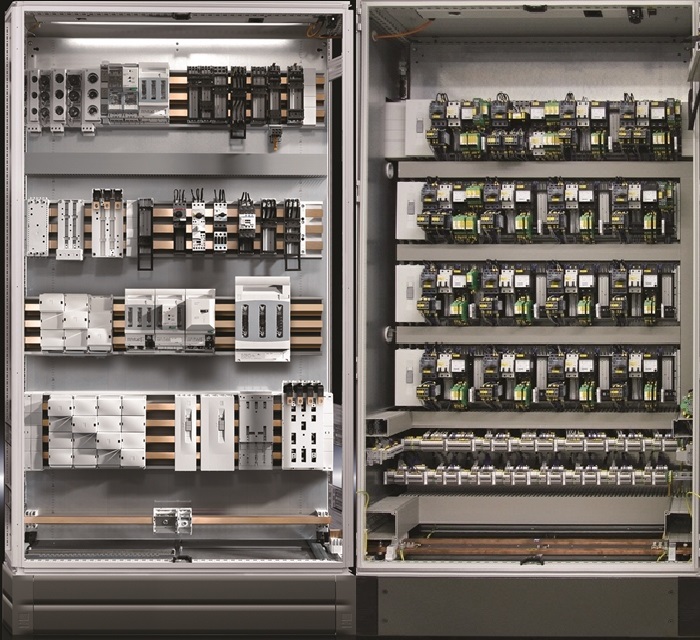By SLAVCO ANASTASOV,
Product Manager,
Rittal Corporation,
www.rittal.com
As power demands increase within enclosures, more manufacturers are turning to busbar systems over traditional wiring. While still growing in North America, busbar systems are the most common power-distribution systems in Europe. In 2017, UL’s Industrial Control Equipment Standard is transitioning from UL 508 to the new UL 60947. The new standard will harmonize the North American UL requirements with the European IEC standard for Low-Voltage Switchgear and Controlgear IEC 60947 series and will further cement IEC devices as the industry standard in the USA for years to come. The next logical step is to follow the IEC dominant power distribution solutions by utilizing busbar systems to further reduce panel space and lower costs.
Currently, busbar systems have approval to IEC, UL, CSA, GL, DNV, and CCC, making them universally sound for widespread installation. Many companies whose products serve foreign markets will specify busbar systems to avoid obsolescence in building enclosure panels.
For reasons ranging from system loads to space efficiency, panel builders are pushing customers away from traditional line-side wiring and bulky components. Still, education is needed. So in the following paragraphs, we present the technical and commercial reasons why busbar systems make so much sense.
Busbar benefits
Busbar systems effectively replace all line-side wiring and distribution blocks in an enclosure. Although traditional wiring costs less up front, the bundled structure of the wires are inflexible and cannot bend into tight formations. Busbar systems may free between 30% and 50% of the wiring space within an enclosure, providing potential cost savings in the selection of a smaller footprint with room for expansion or more space for the components (Fig. 1 ).

Fig. 1: Compared to wired systems (left), busbar systems can be much more compact and simple (right).
Powerful flexibility is designed into a busbar system. Systems rated for currents up to 1,600 A are available with 60-mm bar center distance and 3- or 4-pole designs. Electromagnetic effects and fire hazards are much less of a problem than with wired systems. Busbars also support variable cross-sectioning and top-mounting, so power can be scaled up within an enclosure to meet changing needs.
With wiring, designing the distribution, cable configurations, and wiring diagrams are time-intensive. Extensive electrical calculations are required to determine short-circuit and operating current temperatures. With a busbar system, high short-circuit-protection tolerances are pre-designed at the beginning of the design process. This optimizes control panel design with standard metric sizing to efficiently lay out panel drawings and make changes from one application to the next. Automated, software-assisted system planning and installation instructions make system expansion and modification simple with these modular units.
Likewise, the manual installation of a wiring system is labor-intensive. Power distribution blocks (PDBs) in a three-phase application, for example, would require approximately six holes to be drilled and tapped into the mounting panel, and each end of the feed cables need to be terminated into the block and the main overcurrent protective device. Line-side wiring may require dozens of cables to be manually measured, cut, stripped, routed, labeled, and terminated on both sides. Installation of what may be multiple control devices within the enclosure adds additional labor costs for drilling and mounting. Moreover, there is always the potential for manual error.
The modular design of busbar systems makes it easy to rapidly integrate them. Compared to the labor and production times of traditional wiring, savings may reach 50%. Less panel modification is required to install the components; busbar systems need no bending: the only modification is cutting it to length.
Busbar systems replace all line-side wiring, overcurrent protection devices (OCPDs), PDBs, high-amperage cables, and the lower-amperage cables split out of the PDB into trays. They make installation much simpler; on average, only six holes for busbar supports replace all of the panel holes used to mount the OCPD, PDBs, DIN rail, molded-case circuit breakers, fuse bases, and line-side wiring. What’s more, bus bars, by design, require less wiring work and fewer contact points. All connections to the bus are done via adapters, which are held in place with set screws or spring clips.
Safety, expansion, maintenance, and troubleshooting
Contact hazard protection is a primary concern for all workers. Busbar systems are fully insulated with touch-safe protection, even at connection points. Touch-safe covers for adapters, their terminals, and the bus itself eliminate the risk associated with accidental contact with stray fasteners, dropped tools, or body parts coming in contact with the bus. Unlike power distribution blocks, busbar systems increase arc flash protection with full-surround fault prevention busbar holders.
Busbar systems provide the simplest expansion options available in power distribution. Without additional wiring, new components just snap on to unpopulated portions of the bus system (Fig. 2 ). Busbar systems provide a plug-and-play experience; if operational layouts need to be added or changed, the switch can be made with no loss of uptime. In a traditional control panel, wire sizes are constrained, and there is limited or possibly no room for future expansion.

Fig. 2: Busbar systems provide for easy expansion by allowing components to snap on to unused portions of the various busbar configurations (left). The systems also permit high-density configuration (right).
A control panel using a busbar system can easily be retrofit to accommodate a completely different application. Since none of the devices are screwed into the panel, each component can be removed and swapped with new hardware as needed. If the service life of an enclosure is finished, the busbar can be repurposed into a new enclosure or the copper sold.
Maintenance and troubleshooting of a busbar system are efficient and safe. Line-side wiring does not need to be traced; components can be quickly removed from their adapters. A traditionally wired system may require the initial panel integrator to untangle the wire bundles if a schematic is not available. And with the universal availability of busbar replacement parts, sourcing replacements is simplified.
Advertisement
Learn more about Rittal





